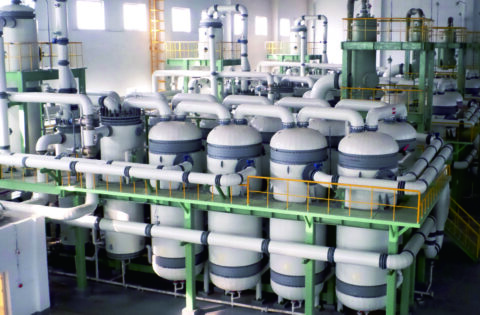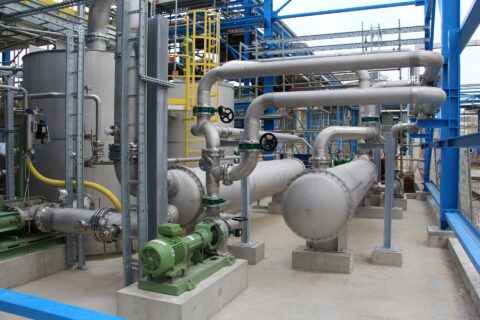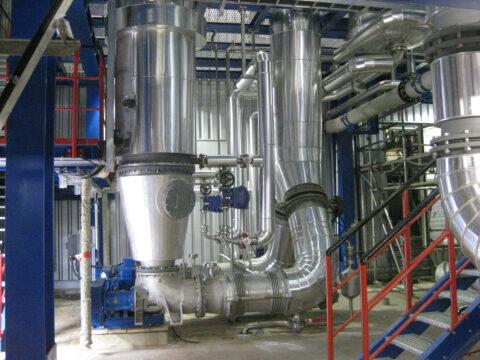
Vacuum Cooling Crystallizers

Functionality and Process of Vacuum Cooling Crystallizers

In vacuum cooling crystallizers, a warm, nearly saturated solution enters a multi-stage vacuum crystallizer (K1-4). Here, the pressure is reduced in stages, leading to the evaporation of the solvent and a cooling of the solution to its boiling temperature. This temperature reduction causes the salt to crystallize. In the crystallizer (K), supersaturation is reduced through crystal growth. The crystals are kept in suspension by air agitation and transported back to the starting position.
The suspension is pumped to the cyclone (Zy) with the suspension pump (SP) for thickening. Subsequently, the liquid is separated in the centrifuge (Z) and the salt is dried in the dryer (T). The resulting vapor can be used in the bath condenser (BK) for preheating the mother liquor or condensed in the mixing condenser (MK) with cooling water. The use of the steam ejector (D) can further reduce the stage pressure and thus the solution temperature. Inert gases are extracted with a vacuum pump (VP).

Vacuum Cooling Crystallizers Principle
Vacuum cooling crystallizers utilizes the adiabatic evaporation of the solvent through pressure reduction to cool a solution, thereby inducing the crystallization of salts without the need for heat exchange surfaces.
Advantages
- Minimization of Crusting: No crusting of cooling surfaces thanks to the absence of heat exchange surfaces.
- Energy Efficient: Possibility for heat recovery and utilization of the vapor.
- Flexible Operation: Adaptability for partial load operation and various applications.
- Adjustable Pressure Conditions: Variable pressure settings for optimal process control.
Variants
- Increase in the Number of Stages: Adjustment for optimization of heat recovery.
- Salt Separation: Optionally integrable.
- Crystallizer Design:
- Horizontal crystallizer with air agitation
- Vertical DTB crystallizers with guide tube and bottom flange agitator
- Vertical FC crystallizers with external circulation loop
- Vacuum Generation: Choice between vacuum pump and steam ejectors.
- Pressure and Temperature Regulation: Lowering pressures and thus the outflow temperature of the solution/suspension by acid condensation or the use of refrigeration machines and refrigerants. Condensation of the vapor from the last stage in mixing condensers or surface condensers.
Frequently Asked Questions
How does residence time in vacuum cooling crystallizers affect crystal size?
By varying the number of stages and extending the crystal residence time, the size and quality of the crystals can be influenced.
What methods for vacuum cooling are available?
Steam ejectors, refrigerants, or condensing agents such as sulfuric acid can be used for vacuum cooling.
How is crusting in vacuum cooling crystallizers avoided?
Since no heat exchange surfaces are needed, crusting and associated maintenance work are eliminated.
Is heat recovery possible in every process step in vacuum cooling crystallizers?
Yes, the vapor can be used for preheating or condensation in various process steps.
Can the vacuum cooling crystallization plant be operated under different pressure conditions?
Yes, the plant allows operation under variable pressure conditions to adjust the outflow
Other Processes









